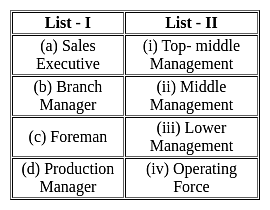TS SET Paper 2 Mock Test - 4 (Commerce) - TS TET MCQ
30 Questions MCQ Test TS SET Mock Test Series 2024 - TS SET Paper 2 Mock Test - 4 (Commerce)
Under which of the following conditions can a proposal be revoked according to the Indian Contract Act 1872?
A. By the communication of notice of revocation by the proposer to the other party
B. By the failure of the acceptor to fulfil a condition of proposal
C. By the death or insanity of the proposer
D. By the lapse of the time prescribed
E. By notice of revocation after the acceptance is communicated.
Big multinational pharmaceutical firms try to exercise influence over the policy decisions made by government departments and regulatory agencies. Which of the following does not reflect how the companies try to exercise their influence?
The managerial function of organising involves:
Read the following statements :
(i) “Working Capital is the amount of funds necessary to cover the cost of operating the enterprise.”
(ii) “Circulating capital means current assets of a company that are changed in the ordinary course of business from one form to another.”
Given below are two statements: One is labelled as Assertion A and the other is labelled as Reason R.
Assertion (A): Median is the middle most item in the set of numbers.
Reasons (R): Mode is not unduly affected by extreme values.
In the light of the above statements, choose the most appropriate answer from the options given below:
Which of the following is not a function of Reserve Bank of India?
Chi square test' measures which of the following?
Which of the following is not a part of PEST?
Who monitors the compliance of SEBI regulations by the mutual fund?
Which among the following is/are not a part of mutual fund trust?
The AMC manages the fund by investing in which of the following?
For regulation of the Insurance Trade in the country the Government has formed:
Arrange the following activities in the process of accounting
A. Journalising the transaction in the ledger accounts
B. Recording the business transaction in the books of entry
C. Preparation of Annual Financial statements
D. Preparation of the Trial Balance
E. Deriving meaningful inferences for business decisions
Choose the correct answer from the options given below:
In which Section of Income Tax Act, exempted incomes have been mentioned ?
Which of the following is not a tier of the Nasdaq Stock Market?
The stock market theory which states that stocks are in equilibrium and impossible for investors to beat the market is classified as an:
Agent is specifically appointed by the principal for a particular task or a general function. This type of appointment is called as:
Who coined the expression “Marketing Mix” ?
Which of the statement (s) is/are true?
Statement I: As per Section 125 of the Indian Contract Act, a contract of indemnity is a contract by which one party promises to save the other party from loss caused to him.
Statement II: The person who promises to indemnify or make good the loss is called the indemnity holder and the person whose loss is made is called indemnifier.
Match the items of List - II with List - I and choose the correct code :

In tax laws, donation to approved and notified association for scientific research is allowed as:
AS - 6 was made mandatory from the accounting period beginning on or after:
Probability sampling and random sampling are:
|
60 tests
|





















